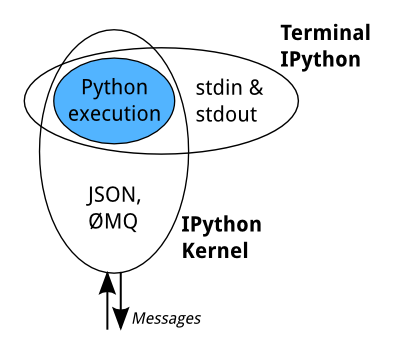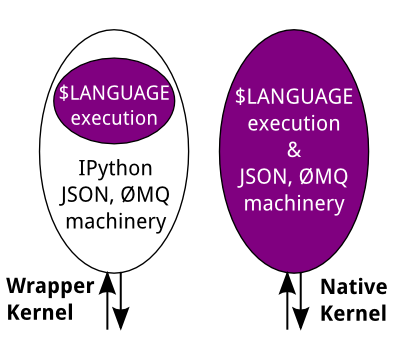How IPython Works
Terminal IPython
When you type ipython, you get the original IPython interface, running in the terminal. It does something like this:
while True:
code = input(">>> ")
exec(code)
Of course, it's much more complicated, because it has to deal with multi-line code, tab completion using :mod:`readline`, magic commands, and so on. But the model is like that: prompt the user for some code, and when they've entered it, exec it in the same process.
The IPython Kernel
All the other interfaces—the Notebook, the Qt console, ipython console in the terminal, and third party interfaces—use the IPython Kernel. This is a separate process which is responsible for running user code, and things like computing possible completions. Frontends communicate with it using JSON messages sent over ZeroMQ sockets; the protocol they use is described in :doc:`messaging`.
The core execution machinery for the kernel is shared with terminal IPython:

A kernel process can be connected to more than one frontend simultaneously. In this case, the different frontends will have access to the same variables.
This design was intended to allow easy development of different frontends based on the same kernel, but it also made it possible to support new languages in the same frontends, by developing kernels in those languages, and we are refining IPython to make that more practical.
Today, there are two ways to develop a kernel for another language. Wrapper kernels reuse the communications machinery from IPython, and implement only the core execution part. Native kernels implement execution and communications in the target language:

Notebooks
The Notebook frontend does something extra. In addition to running your code, it stores code and output, together with markdown notes, in an editable document called a notebook. When you save it, this is sent from your browser to the notebook server, which saves it on disk as a JSON file with a .ipynb extension.
The notebook server, not the kernel, is responsible for saving and loading notebooks, so you can edit notebooks even if you don't have the kernel for that language—you just won't be able to run code. The kernel doesn't know anything about the notebook document: it just gets sent cells of code to execute when the user runs them.
